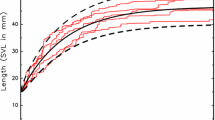Summary
An equation is given for the estimation of selective values from data obtained by mark-recapture experiments, assuming that selective pressures remain constant while the experiments are carried out. The equation does not have an explicit solution but can readily be solved using a trial-and-error method.
The use of the equation is illustrated on some data reported byKettlewell et al. (1969) from an experiment involvingtypica andedda morphs of the mothAmathes glareosa. It is found that theedda morph apparently had a selective advantage of about 12% per day compared to thetypica morph and that this is significantly different from zero. Using another methodKettlewell concluded that the selective advantage of theedda morph was only 7% and that this was not statistically significant.
Similar content being viewed by others
References
Brower, L. P., J. V. Z. Brower, F. G. Stiles, H. J. Croze, andA. S. Hower, (1964) Mimicry: Differential advantage of colour-patterns in the natural environment.Science 144: 183–185.
Brower, L. P., L. M. Cook, andH. J. Croze, (1967) Predator responses to artificial Batesian mimics released in a neotropical environment.Evolution 21: 11–23.
Cook, L. M., L. P. Brower andJ. Alcock, (1969) An attemp to verify mimetic advantage in a neotropical environment.Evolution 23: 339–345.
Cook, L. M. (1971)Coefficients of natural selection. Hutchinson, London.
Ford, E. B. (1971)Ecological genetics. Chapman and Hall, London.
Kendall, M. G. andA. Stuart, (1963)The advanced theory of statistics, vol. 1. Griffin, London.
Kettlewell, H. B. D. (1955) Selection experiments on industrial melanism in the Lepidoptera.Heredity 9: 323–342.
Kettlewell, H. B. D. (1956) Further selection experiments on industrial melanism in the Lepidoptera.Heredity 10: 287–301.
Kettlewell, H. B. D. andR. J. Berry (1961) The study of a cline.Heredity 16: 403–414.
Kettlewell, H. B. D. andR. J. Berry (1969) Gene flow in a cline.Heredity 24: 1–14.
Kettlewell, H. B. D., R. J. Berry, C. J. Cadbury, andG. C. Phillips (1969) Differences in behaviour, dominance and survival within a cline.Heredity 24: 15–25.
Manly, B. F. J. (1972) Estimating selective values from field data.Biometrics 28 (in press).
Author information
Authors and Affiliations
Rights and permissions
About this article
Cite this article
Manly, B.F.J. A note on the estimation of selective values from recaptures of marked animals when selection pressures remain constant over time. Res Popul Ecol 14, 151–158 (1973). https://doi.org/10.1007/BF02518840
Issue Date:
DOI: https://doi.org/10.1007/BF02518840




